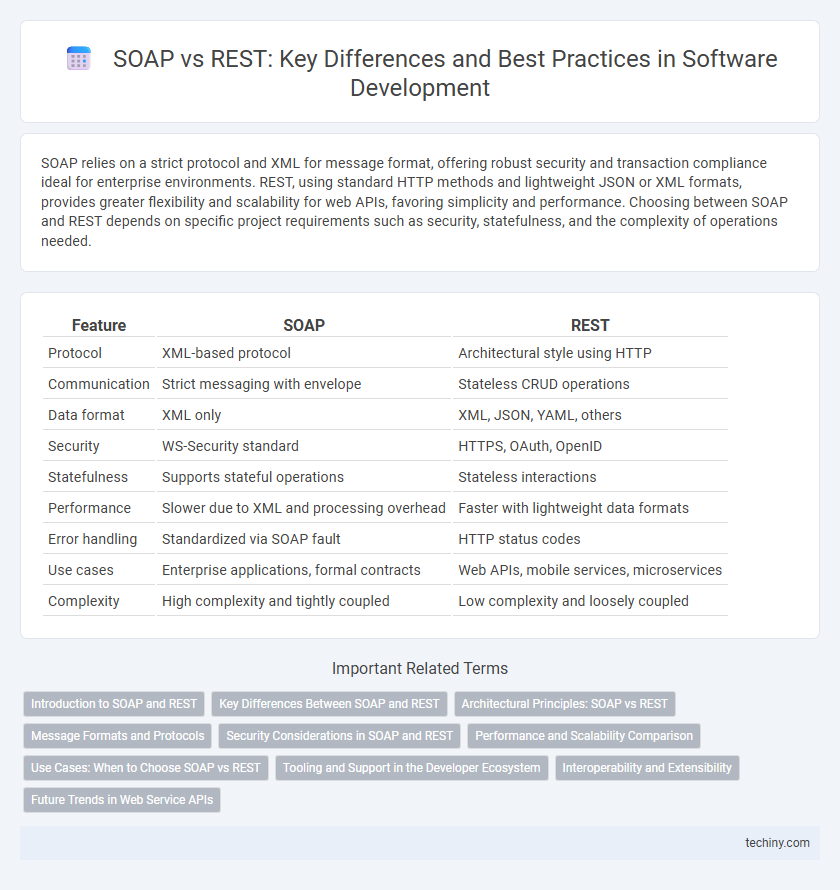SOAP relies on a strict protocol and XML for message format, offering robust security and transaction compliance ideal for enterprise environments. REST, using standard HTTP methods and lightweight JSON or XML formats, provides greater flexibility and scalability for web APIs, favoring simplicity and performance. Choosing between SOAP and REST depends on specific project requirements such as security, statefulness, and the complexity of operations needed.
Table of Comparison
| Feature | SOAP | REST |
|---|---|---|
| Protocol | XML-based protocol | Architectural style using HTTP |
| Communication | Strict messaging with envelope | Stateless CRUD operations |
| Data format | XML only | XML, JSON, YAML, others |
| Security | WS-Security standard | HTTPS, OAuth, OpenID |
| Statefulness | Supports stateful operations | Stateless interactions |
| Performance | Slower due to XML and processing overhead | Faster with lightweight data formats |
| Error handling | Standardized via SOAP fault | HTTP status codes |
| Use cases | Enterprise applications, formal contracts | Web APIs, mobile services, microservices |
| Complexity | High complexity and tightly coupled | Low complexity and loosely coupled |
Introduction to SOAP and REST
SOAP (Simple Object Access Protocol) is a protocol designed for exchanging structured information in web services, relying on XML for message format and typically using HTTP or SMTP for transmission. REST (Representational State Transfer) is an architectural style that uses standard HTTP methods and flexible formats like JSON or XML to enable stateless communication between client and server. Both SOAP and REST facilitate web service integration, with SOAP emphasizing formal contracts through WSDL and REST emphasizing scalability and simplicity.
Key Differences Between SOAP and REST
SOAP uses a strict protocol with XML messaging format, enabling formal contracts through WSDL, while REST leverages stateless architecture and supports multiple data formats such as JSON, XML, and HTML. SOAP's operation is designed for high security and transaction compliance via standards like WS-Security, whereas REST emphasizes simplicity and scalability with stateless CRUD operations over HTTP. REST APIs typically deliver faster performance and easier integration for web and mobile applications compared to the more rigid and heavyweight SOAP services.
Architectural Principles: SOAP vs REST
SOAP is a protocol with strict standards for message format, security, and transaction compliance, emphasizing formal contracts through WSDL and relying on XML for data exchange. REST is an architectural style leveraging stateless communication and uniform interfaces, commonly using HTTP methods (GET, POST, PUT, DELETE) and supporting multiple data formats like JSON and XML. SOAP enforces rigid contracts and built-in security features, whereas REST provides flexibility with lightweight protocols ideal for web-scale and mobile applications.
Message Formats and Protocols
SOAP relies on XML exclusively for message formatting, ensuring strict standards and extensible schemas suitable for complex enterprise applications. REST supports multiple message formats including JSON, XML, HTML, and plain text, providing flexibility and lightweight data interchange optimized for web and mobile integration. SOAP operates primarily over HTTP, SMTP, and other protocols with built-in WS-* standards, while REST strictly utilizes HTTP methods such as GET, POST, PUT, and DELETE to facilitate stateless communication.
Security Considerations in SOAP and REST
SOAP provides robust security features through WS-Security standards, including message integrity, encryption, and authentication using XML signatures and tokens, making it suitable for enterprise-level applications requiring stringent security. REST relies on underlying transport security mechanisms like HTTPS and OAuth for authentication and data encryption but lacks built-in security standards, which may pose risks in scenarios needing message-level protection. Choosing between SOAP and REST requires evaluating the specific security requirements, such as the need for end-to-end message security versus simpler, transport-layer security protocols.
Performance and Scalability Comparison
REST APIs typically offer better performance than SOAP due to their lightweight JSON format and stateless architecture, reducing server load and latency. SOAP's XML-based messaging makes it more resource-intensive, which can limit scalability in high-traffic environments. REST's scalability is enhanced by caching mechanisms and load balancing, enabling efficient handling of numerous concurrent requests.
Use Cases: When to Choose SOAP vs REST
SOAP is preferred for enterprise-level applications requiring high security, reliability, and formal contracts, such as payment gateways, banking services, and telecommunication systems. REST is ideal for web and mobile applications needing scalability, flexibility, and faster performance, commonly used in social media platforms, cloud services, and IoT devices. Choosing SOAP or REST depends on factors like transaction complexity, stateful operations, and support for multiple protocols.
Tooling and Support in the Developer Ecosystem
SOAP benefits from comprehensive tooling and mature support in enterprise environments, featuring robust standards for security, transactions, and messaging. REST leverages lightweight protocols with broad compatibility across modern development frameworks, enabling faster integration and extensive community-driven libraries and tools. Developer ecosystems favor REST due to its simplicity and flexibility, while SOAP's tooling excels in scenarios demanding strict contract adherence and complex workflows.
Interoperability and Extensibility
SOAP provides strong interoperability through its strict standards and built-in protocol support, ensuring reliable communication across diverse platforms and languages. REST offers greater extensibility by leveraging flexible data formats like JSON and XML, making it easier to evolve APIs and integrate with modern web technologies. Both protocols support cross-platform interactions, but SOAP's formal structure suits complex enterprise environments while REST excels in scalable, lightweight web services.
Future Trends in Web Service APIs
Web service APIs are increasingly favoring REST over SOAP due to REST's lightweight architecture and better scalability for modern cloud-native applications. Emerging trends include the adoption of GraphQL and gRPC, which provide more efficient data querying and communication capabilities compared to traditional REST and SOAP protocols. Enhanced security protocols and real-time data streaming integration are becoming standard to support the future of highly interactive and secure web services.
SOAP vs REST Infographic

 techiny.com
techiny.com